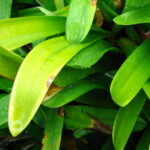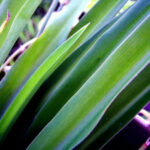Want a simple plant to grow that doesn’t require a lot of maintenance? Well then, you should try growing a potted ivy plant.
Sunlight & Temperature
Ivy plants prefer bright non-direct light. If you place them in direct light, then the leaves may start to wilt and turn black. However, this is less likely to occur if the temperature is not very hot. Once the temperature soars past eighty-five degrees Fahrenheit or so, the likelihood of the ivy dying from direct sunlight is greater. But keep them out of the direct light just to be safe.
The ideal temperature range for ivies is seventy to eighty degrees. The cold will not kill your ivy unless it freezes. Ivies will enter a type of hibernation if the temperatures become fairly cool (below fifty degrees Fahrenheit or so). And as long as they are not in direct light, then they can stay outside even when it’s around a hundred degrees Fahrenheit. Just be sure that they are watered more frequently, and remember to keep them out of the sun.
Water & Fertilizer
You should water and fertilize your ivies more in the spring and summer months, and give them less nutrients in the autumn and winter months. This is mostly due to the plant growing less in the autumn and winter months. Miracle-Gro is fine for fertilizer.
Soil
A normal potted mix soil of some sort will do nicely. Simply make sure that the soil retains its moisture well because you don’t want ivies to dry out too much. When ivies become too dry or even too wet, their leaves may turn yellow and start to shed. If this happens, then prune off the yellow leaves and adjust your watering methods. Placing some rocks at the bottom of the pot may help with the draining process; however, it’s not required. And never allow your ivy to sit in any water.
Type of Pot
It’s best to just use plastic pots for ivy plants due to their ability to help keep the soil moist. And it is recommended to re-pot your ivy every couple of years as this will aid in keeping your ivy healthy. It will also promote growth. Some people simply place their ivies in a glass bottle full of water. This may keep the plant alive for months or even years; unfortunately, it will also slowly kill the plant. It’s probably best if you avoid using this method.
Propagation
The easiest way to cultivate ivies is to simply slice off a vine. By slicing off a vine, you should take a few inches worth of the ivy’s stem and cut it off. Make sure that there are a few leaves on this stem, then just soak it in water for a week or two. At the end of this time frame, you should start noticing tiny white roots. Once you see these roots, go ahead and place the cutting in a small pot full of moist soil. Keep the soil damp for a few weeks, and then treat the cutting as you would a normal plant. To encourage a thicker clump of leaves, simply prune away any parts of the vine that are growing too long. This will cause more vines to grow in the center of the plant; thus, the “clumping effect” takes place. Just so you know, ivies do not have a flower. At least not the potted varieties.
Pests & Diseases
Since most of you will probably be growing your ivy plants indoors, you will not have much to worry about. Ivy plants are usually very hardy plants, and they can take a lot of abuse. If you over-water your ivy plant, then it could develop root rot. In which case, you’ll need to cut back on your watering. You may also need to propagate the plant (mentioned above) in order to save it. It just depends on how far gone the roots are.
If your ivy plant is outside, then you may run into a few additional problems. Sometimes certain types of ants called leaf-cutter ants will strip the ivies of their leaves. You’ll know if it’s leaf-cutter ants because in addition to your ivies being stripped of their foliage, so will everything else around them (maybe not the trees). Leaf-cutter ants are generally found in the countryside, and individuals who live in the city should not have to deal with these pests. If you do have leaf-cutter ants though, then bring your ivy plants inside immediately. And don’t put them back outside unless you’re certain the leaf-cutter ants are really gone.
Grasshoppers can also be a bit of a menace if they’re really hungry, but most of the time they don’t seem very interested in ivies. Sometimes birds can tear up your ivy plant if it’s outside because they may be looking for some leaves to place in their nest. Or they may just tear up the soil (and the roots) while looking for worms.
Potted ivy plants are a hardy houseplant that can stand a lot of abuse. They are not invincible though, so be sure to take care of them. If you do, then you will have houseplants that can even outlast your pets.





